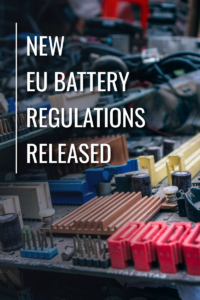EU Battery Regulation
August 24, 2023 | Written by GreenSoft Technology, Inc.
New EU Battery Regulation Released
 EU Battery Directive repealed and replaced with new EU Battery Regulation
EU Battery Directive repealed and replaced with new EU Battery Regulation
On July 28, the European Commission published a new Battery Regulation, and announced the upcoming repeal of the previous EU Battery Directive.
Regulation (EU) 2023/1542 is effective August 18, 2023. The previous EU Battery Directive 2006/66/EC will be repealed on August 18, 2025.
The new Battery Regulation has a similar scope and similar product categories as the previous EU Battery Directive; however, the new Battery Regulation includes additional substance restrictions and labeling requirements.
The full text of the new regulation can be found here.
Mercury, Cadmium, and Lead substance restrictions
As in the old version, batteries shall not contain more than 0.0005% of Mercury (CAS No 7439-97-6) or its compounds by weight, and portable batteries shall not contain more than 0.002% of Cadmium (CAS No 7440-43-9) and its compounds by weight. However, the new EU Battery Regulation also includes restrictions on Lead (CAS No 7439-92-1) and its compounds.
While the previous EU Battery Directive contained marking requirements for Lead, it did not restrict the usage of Lead. Under the new EU Battery Regulation, portable batteries, whether or not incorporated into appliances, shall not contain more than 0.01% of Lead by weight, effective August 18, 2024. For portable zinc-air button cells, the restriction takes effect on August 18, 2028.
Updated product labeling requirements
As with the prior EU Battery Directive, under the new EU Battery Regulation all batteries containing more than 0.002% Cadmium or more than 0.004% Lead must be marked with the chemical symbol for the metal concerned: Cd or Pb.
Additionally, as of August 18, 2025, affected products must be marked with a symbol indicating separate collection of batteries. And starting February 18, 2027, all batteries must be marked with a QR code that provides access to the following information:
- For LMT batteries, industrial batteries with a capacity greater than 2kWh and electric vehicles batteries, the battery passport in accordance with Article 77;
- For other batteries, the applicable information referred to in paragraphs 1 to 5 of this Article, the declaration of conformity referred to in Article 18, the report referred to in Article 52(3) and the information regarding the prevention and management of waste batteries laid down in Article 74(1), points (a) to (f); and
- For SLI batteries, the amount of cobalt, lead, lithium or nickel recovered from waste and present in active materials in the battery, calculated in accordance with Article 8.
Further labeling requirements in the new EU Battery Regulation include:
- Beginning August 18, 2026, batteries shall bear a label containing the general information on batteries, including the manufacturer, battery category, and the hazardous substances present in the battery other than Mercury, Cadmium or Lead;
- Rechargeable portable batteries, LMT batteries and SLI batteries shall bear a label containing information on their capacity; and
- Non-rechargeable portable batteries shall bear a label containing information on their minimum average duration when used in specific applications and a label indicating ‘non-rechargeable’.
Identifying hazardous substances in products
GreenSoft Technology, Inc. provides Data Services and GreenData Manager software to help companies identify the presence and amounts of hazardous substances in their products, including Mercury, Cadmium, and Lead.
Our data collection team will contact your suppliers on your behalf to obtain data on the substances contained in your products and components, and validate that data for completeness and accuracy. We’ll provide reports in a variety of formats, or generate reports yourself using GreenData Manager software, so that you can easily show compliance with the EU Battery Regulation and other global environmental regulations.
Contact us to learn more.





